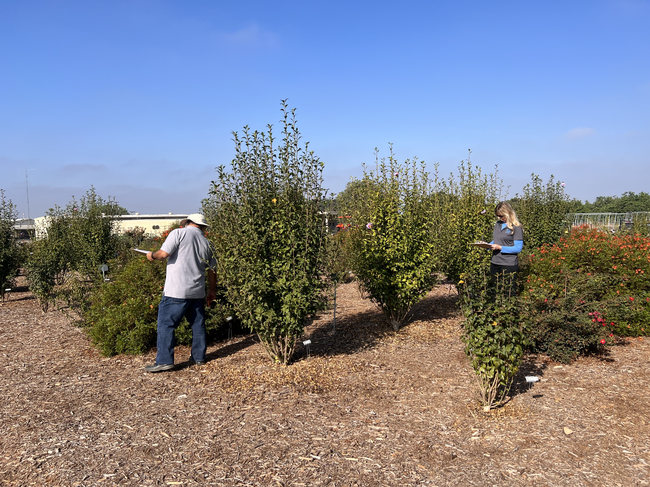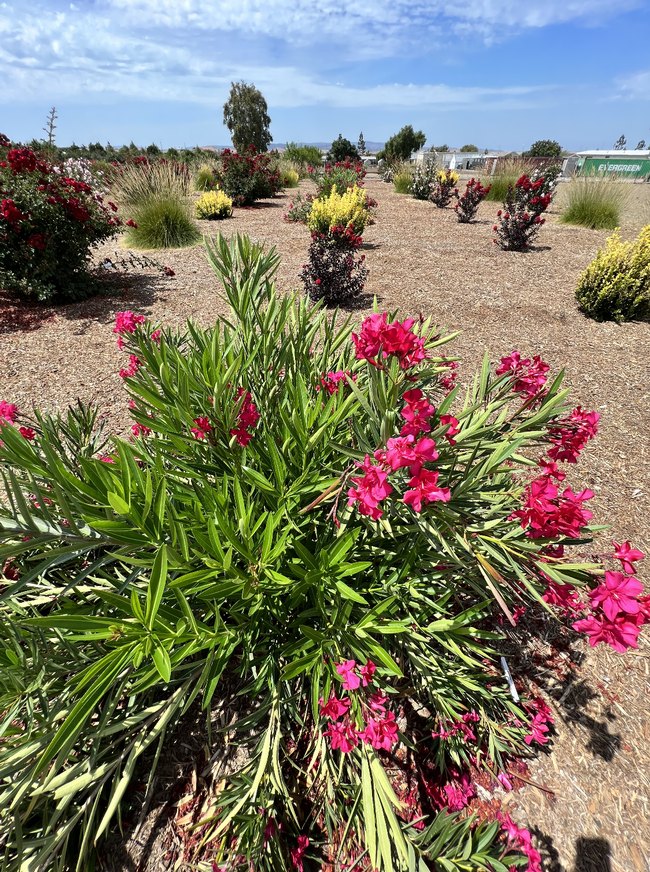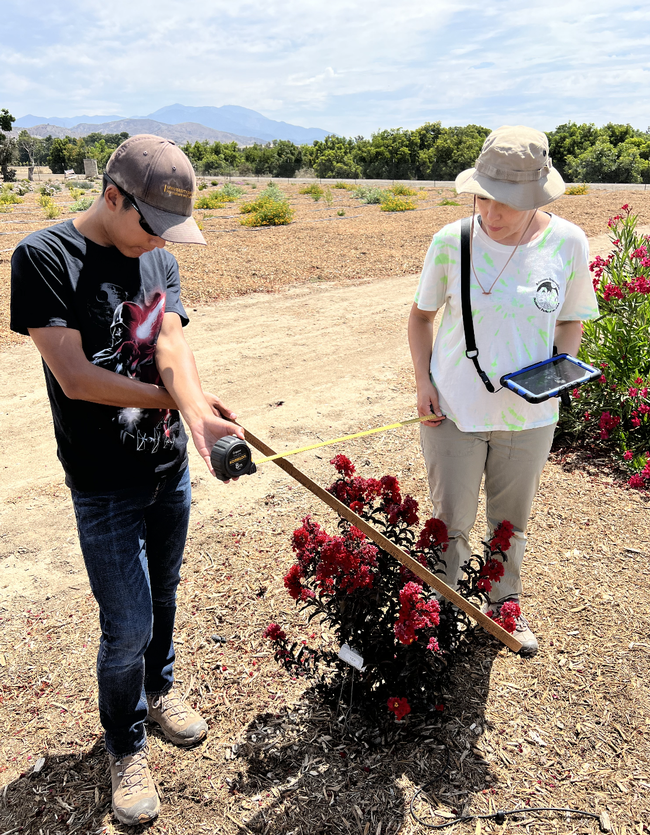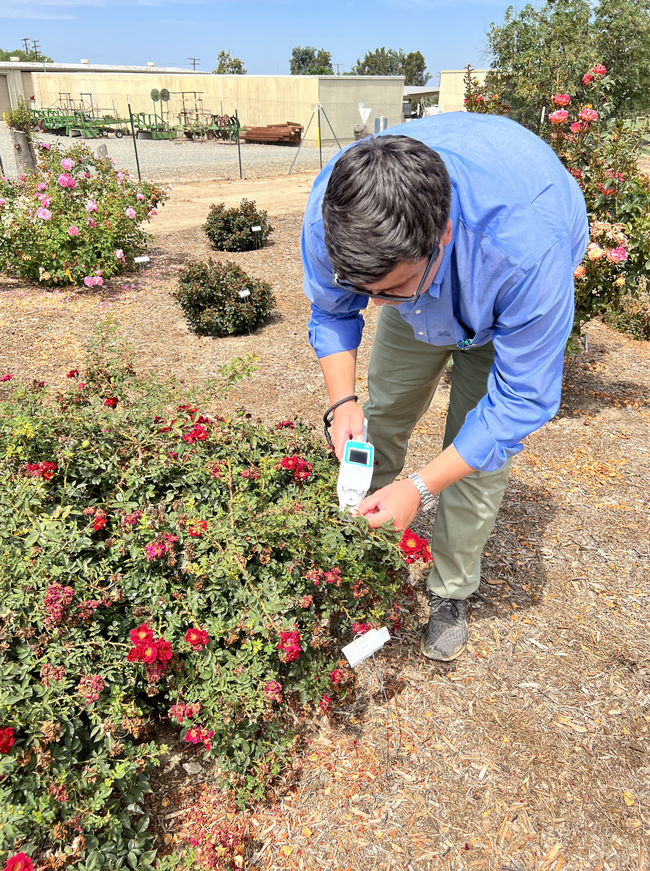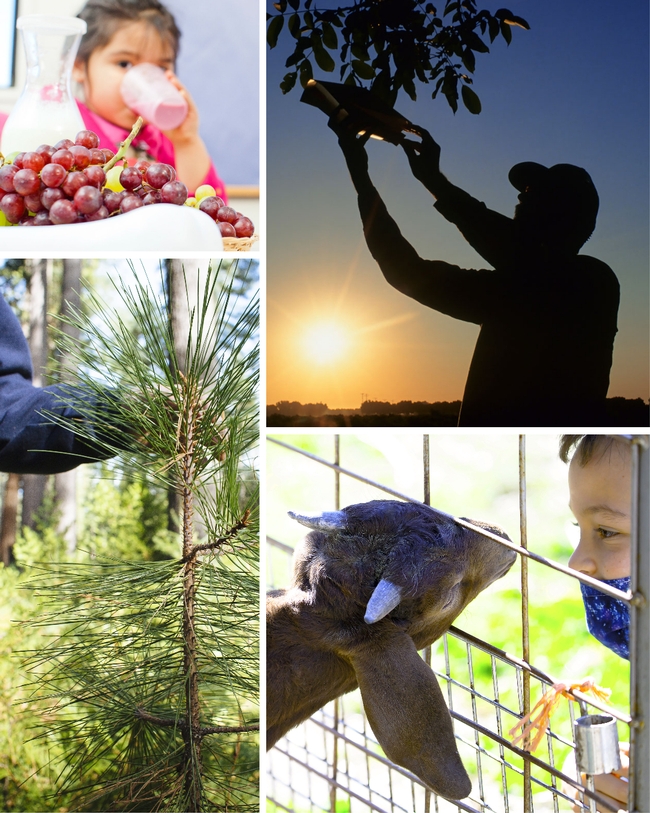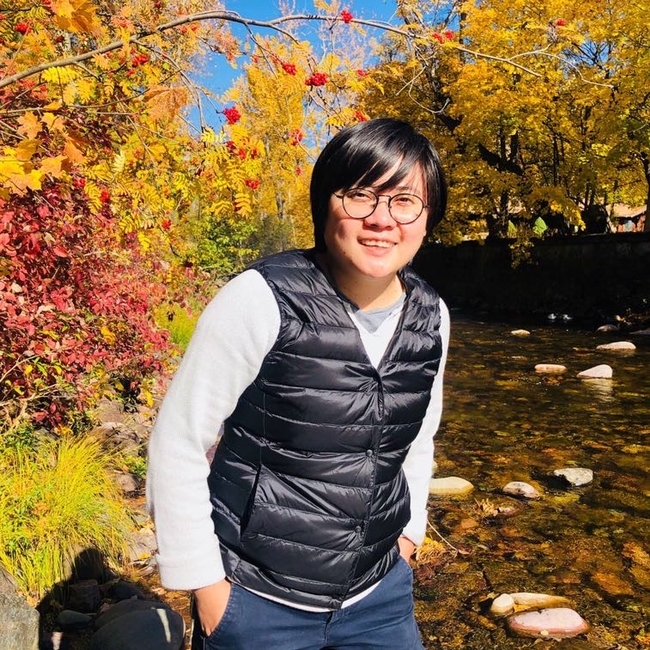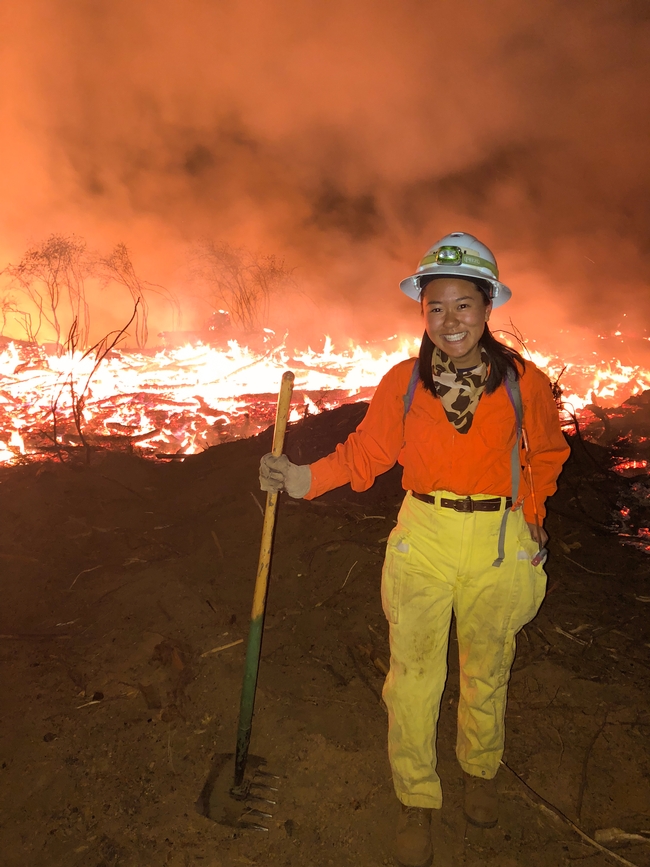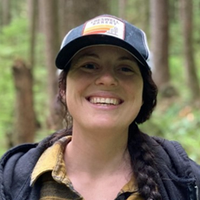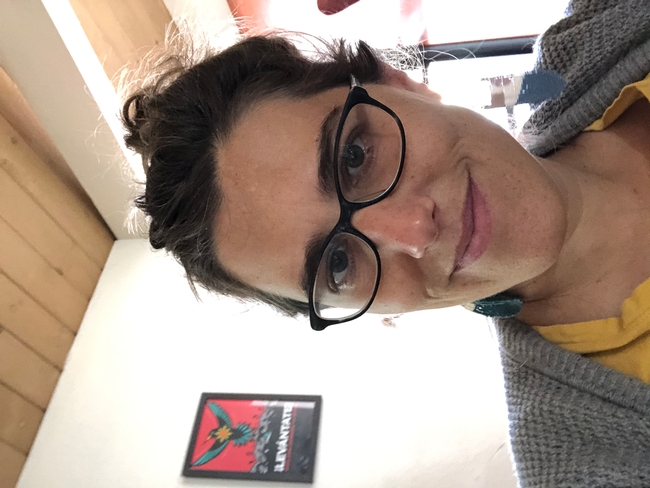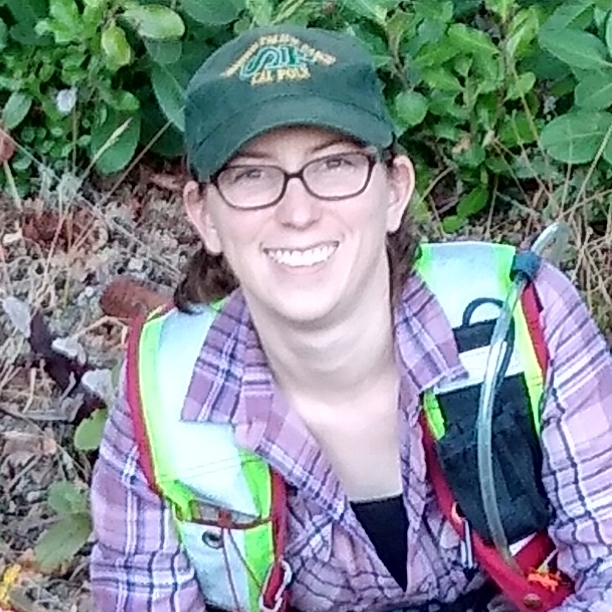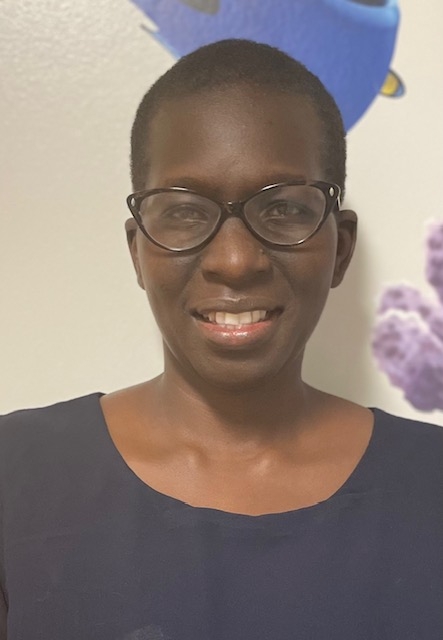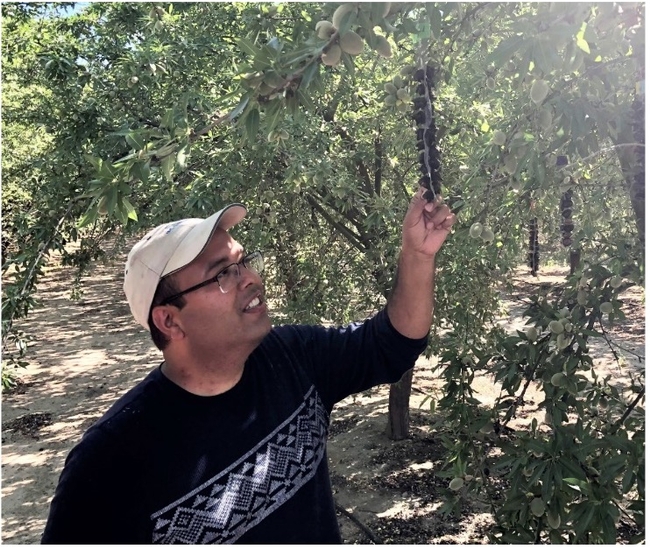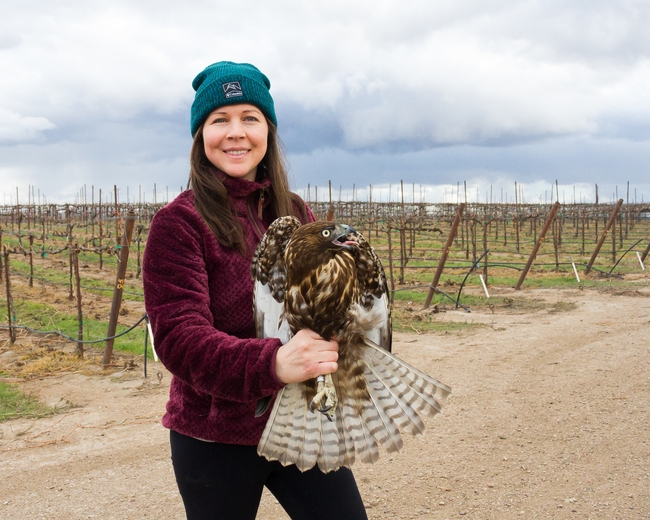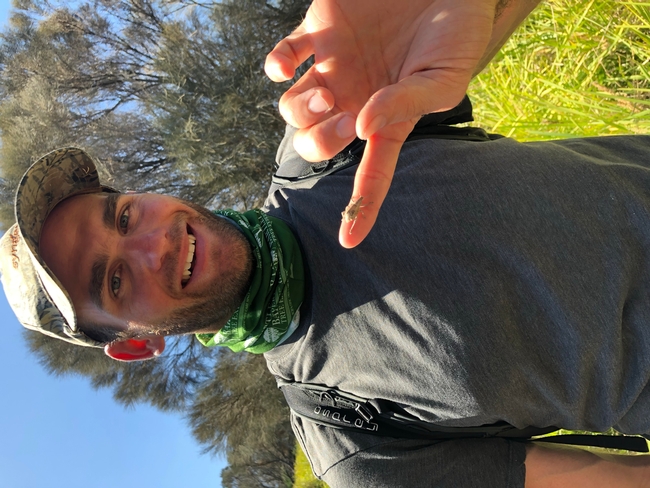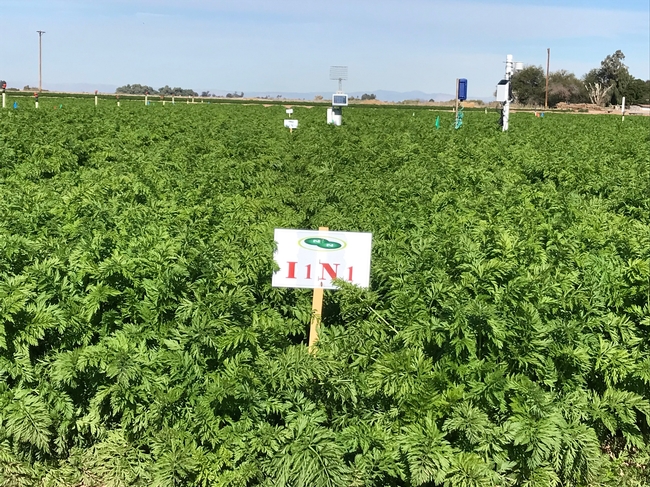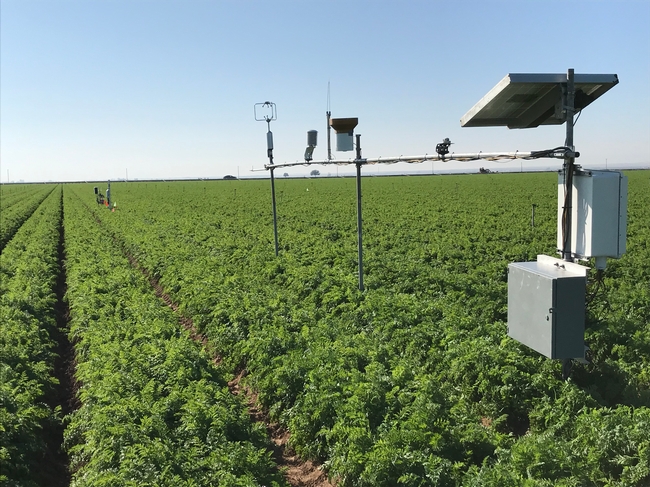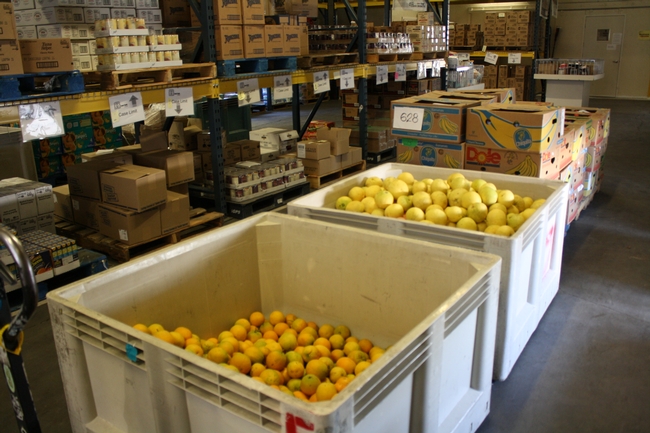Posts Tagged: low
Your water-efficient landscape doesn’t have to be barren
UC climate-ready landscape trials identify low-water yet attractive plants
Good news: roses can be a part of your water-efficient landscape. Lorence Oki, UC Cooperative Extension environmental horticulture specialist in the UC Davis Department of Plant Sciences, identified rose cultivars that remain aesthetically pleasing with little water.
Oki is the principal investigator of the Climate-Ready Landscape Plants project, which may be the largest irrigation trial in the western U.S., and the UC Plant Landscape Irrigation Trials (UCLPIT), the California component of that project. These projects evaluate landscape plants under varying irrigation levels to determine their optimal performance in regions requiring supplemental summer water.
“There are some assumptions that pretty plants use a lot of water, like roses,” Oki said. “Everyone thinks they need a lot of water, but we've found some that don't, and they still look great. A water-efficient landscape doesn't need to look like a Central Valley oak-grassland in the summer. It can look really attractive.”
In 2021, Oki's team at UC Davis identified Lomandra confertifolia ssp. pallida "Pom Pom" Shorty and Rosa "Sprogreatpink" Brick House® Pink as two of the best low-water plants in the trial.
“The useful tip or information that is shared at the end of each trial is the selection and designation of plants as Blue Ribbon winners. These are the plants that looked good with an overall rating of 4 or higher throughout and were on the low (20%) water treatment,” said Natalie Levy, associate specialist for water resources, who manages the project at the UC ANR South Coast Research and Extension Center.
How plants earn a blue ribbon
Each trial year, the selection of new plants is based on research recommendations and donated submissions from the nursery industry. The landscape plants are trialed in full sun or 50% shade cover.
Irrigation treatments are based on the rate of evaporation and plant transpiration (evapotranspiration) measured through a local California Irrigation Management Information System (CIMIS) weather station that provides a reference evapotranspiration (ETo) rate.
Three levels of irrigation are provided to the plants equal to 20%, 50%, and 80% of ETo. The volume of water applied is the same at each irrigation based on soil characteristics, but the interval between applications varies with weather and the treatment. Using this method, irrigations for the 20% treatment are less frequent than the 80% treatment.
“The 20% treatment during the 2022 trial was irrigated an average of once per month while the 80% treatment was irrigated weekly,” explained Levy.
During the deficit irrigation trial, monthly height and width measurements are taken to determine the plant growth index. Monthly qualitative aesthetic ratings on a scale of 1 to 5 are determined for foliage appearance, flowering abundance, pest tolerance, disease resistance, vigor and overall appearance.
A second round of flowering abundance and overall appearance measurements are also taken to capture more of the blooming period. For example, UCLPIT identified in the 2020 trial at South Coast REC that the "Apricot Drift" rose had a mean overall appearance score of 3.5 out of 5, deeming it “acceptable to very nice” and a low water use plant within the Water Use Classification of Landscape Species or WUCOLS guide.
Project expands options for landscape planting
“(WUCOLS) only has 3,500 plants in it. There are guesses that there are close to 10,000 cultivars in urban landscapes in California, if not more,” said Oki. “WUCOLS also didn't have numerical ratings. Instead, you'll see verbal ratings like ‘low water use' or ‘high water use.'”
The UCLPIT project has not only developed numerical recommendations for irrigation, but it has also added new landscape plants that are compliant with California's Model Water Efficient Landscape Ordinance. In fact, UCLPIT's data is one of the few sources that can be used to supplement WUCOLS.
Geographic diversity of trial sites adds to knowledge base
In addition to UC Davis and South Coast REC in Irvine, the trials have expanded beyond California as the Climate-Ready Landscape Plants project and is in progress at Oregon State University, University of Washington, University of Arizona and Utah State University thanks to a USDA/CDFA grant awarded in 2020.
Lloyd Nackley, associate professor of nursery production and greenhouse management at Oregon State University, is the principal investigator of the trial in the Portland metro area, which is entering its third year.
“People know that there are drought tolerant plants, but there are many. We're trying to highlight lesser known or newer varieties. And even though the trial is three years, most gardeners would hope that their garden lasts longer than that,” said Nackley.
One of the observations that Nackley recalls is of the Hibiscus Purple Pillar plant. Unlike the trial at South Coast, the Purple Pillar did not perform well in Oregon in the spring.
“It wasn't until August that we saw the plant bloom and begin to look like what we saw from South Coast in April,” Nackley said.
Ursula Schuch, horticulture professor and principal investigator of the trial taking place at the University of Arizona, was also surprised at the range of performance among different plant types and the effects of irrigation, heat and temperature.
“This research will reassure green industry professionals that they can stretch their water budget to successfully cultivate more plants, watering them according to their needs instead of irrigating every plant according to the highest water-using plants,” said Schuch.
Although research is only conducted in the West, the hope is that there will be trials in other regions of U.S.
Doing so would yield comprehensive information about the plants and their performance in different climates. As extreme weather events persist in the U.S., disease pressure and risks do too. Trials throughout the country would provide location-specific data regarding disease susceptibility.
To learn more about the UCLPIT research project, visit https://ucanr.edu/sites/UCLPIT/
New UCCE advisors offer expertise in food systems, fire, 4-H and more
University of California Agriculture and Natural Resources continued hiring county-based scientists at a rapid pace over the summer. With increased funding from Gov. Gavin Newsom and the state Legislature, UC ANR recently hired UC Cooperative Extension advisors who bring expertise in wood products, wildfire, wildlife, food systems, urban and small-scale farms, 4-H youth development, pest management, drought, nutrition and environmental horticulture.
UC Cooperative Extension advisors work directly with community members to apply research-based information to improve the lives and livelihoods of Californians.
To see a list of UC Cooperative Extension advisors who have joined in the past few months, visit https://ucanr.edu/About/DirectorySearch/Recent_Hires. The most recently hired advisors are introduced below.
Chen named woody biomass and wood products advisor
Cindy Chen joined UC Cooperative Extension Sept. 6 as a woody biomass and wood products advisor for the Central Sierra and Alpine and Mariposa counties.
After receiving her bachelor's in social ecology and master's in demography from UC Irvine, Chen completed her Ph.D. in environmental and forest sciences from the University of Washington, specializing in wood products processing and marketing. Chen has worked and lived in all three West Coast states over the past 20 years and she is familiar with the natural environment in the western U.S.
Her multidisciplinary expertise allows her to work on a wide range of projects covering topics such as population forecasting, environmental assessment, woody biomass transportation logistics, the end-of-life treatment of wood products and mass timber production optimization.
Chen has worked with nonprofit organizations, government agencies, research scientists and local stakeholders to investigate the environmental and economic benefits of wood utilization in the construction and energy industries. Her work in evaluating the environmental impacts of Cross Laminated Timber (CLT) production helped prepare for the opening of North America's largest mass timber manufacturing facility in Washington.
In addition to her work in the U.S., Chen also has collaborated extensively with international partners in research projects that explored the global market potential for wood products and bioenergy.
About this position, Chen says, “As the woody biomass and forest products advisor at UC ANR, my goal is to work with the Central Sierra communities in exploring innovative ways to better utilize California's forest resources and biomass, developing biomass processing programs that are appropriate for the region and contributing to local economic development.”
Chen is based in Tuolumne and can be reached at cxnchen@ucanr.edu.
Low brings fire expertise to communities statewide
Katie Low, who began as the University of California Cooperative Extension statewide fire coordinator on Sept. 1, will fulfill two important functions for UC ANR's team of fire experts.
First, she will coordinate and partner with UCCE fire advisors throughout California to develop and deliver wildfire-related science and outreach materials for a wide range of communities across the state. Low said encouraging diversity in the network of fire experts and engaged communities will be crucial.
“One of my goals is to help build and maintain a diverse and inclusive community of fire and natural resource professionals,” she said.
Second, based at the UCCE office in Auburn, Low will collaborate with local natural resource professionals and residents in Nevada and Placer counties on projects that bolster community and ecosystem resilience to wildfire and climate change.
“I look forward to working with community groups, land managers and scientists to implement viable fire-resilient management strategies for ecosystems in the region and statewide,” Low said.
Equipped with bachelor's degrees in geography and ecosystems management and forestry, as well as a master's in forestry, all from UC Berkeley, Low brings a wealth of knowledge and a variety of experience.
As a fire and forest ecologist, she studied the impacts of fuels-reduction and forest-restoration treatments on Sierra Nevada mixed-conifer forests. Low also worked as operations coordinator for the California Outdoor Engagement Coalition, and as a forestry aide for the California Department of Forestry and Fire Protection's Forest Biometrics Program.
Low can be reached at (530) 889-7385 and katlow@ucanr.edu; follow her on Twitter @lowseverityfire.
Deak named fire advisor for Mariposa, Fresno and Madera counties
Alison Deak joined UC Cooperative Extension on Aug. 22 as a fire advisor for Mariposa, Fresno and Madera counties. Since she began work, Deak has been focused on conducting a needs assessment and building rapport with community leaders.
Her role as fire advisor will include promoting the use of prescribed fire to help restore fire adapted landscapes. She will also prioritize community education, applied research and partnership building efforts that are based on scientifically informed ways to help communities mitigate, prepare for, and recover from wildfire.
Originally from northeast Ohio where there are no wildfires according to Deak, it was not until she moved to Colorado for college that she learned of their impact.
When the 2012 Waldo Canyon Fire occurred, Deak felt like her playground was burning down so she acted. She began volunteering with the wildfire recovery effort and her career into fire science took off from there.
Deak earned a bachelor's degree in geography and environmental studies from the University of Colorado, Colorado Springs and master's degrees in geography and nonprofit management from the University of Oregon.
Before moving to California and joining UC ANR, Deak worked as a wildland firefighter with the U.S. Forest Service and Bureau of Land Management.
When asked what she is looking forward to most, Deak shared that she is passionate about increasing diversity in the fire science field and, particularly, empowering more women to join. She is eager to help community members prepare for wildfire and mitigate fire risk in a safe and competent manner.
Deak is located at the UC Cooperative Extension office in Mariposa County and can be reached at aldeak@ucanr.edu.
Henry joins UC ANR as food systems advisor for capitol region
Olivia Henry joined UC ANR on Aug. 15 as regional food systems area advisor for Solano, Yolo, Sacramento, Placer and Nevada counties. Henry will focus on issues related to marketing, resilient supply chains, distribution infrastructure, processing infrastructure, financing models and food waste.
Prior to joining UC ANR, Henry worked in various newsrooms – including CapRadio, the Mendocino Voice, KALW Public Radio, San Francisco Public Press and Mother Jones – in community engagement, membership and communications roles. She also worked with Internews, a media development organization, to conduct information needs assessments in the San Joaquin Valley and Inland Empire regions.
Henry is still involved with community media, and currently serves as the assistant editor of a bimonthly, English and Spanish-language newspaper, “The Ivanhoe Sol,” in rural Tulare County.
She earned her bachelor's degree in journalism from Western Washington University and master's degree in community development from UC Davis. While at Davis, Henry studied models of community- and employee-owned news enterprises, with a focus on how stakeholder ownership can protect journalism as a public good. She also earned a graduate certificate in extension outreach and communication.
Henry said she is excited to be a part of UC ANR, which she has benefitted from as a certified California Naturalist and candidate California Master Beekeeper. She has previously worked at local farms, including a diversified orchard and targeted grazing operation.
Henry is based in Fairfield and can be reached at omhenry@ucanr.edu.
Neas named 4-H advisor for San Mateo, San Francisco counties
Sally Neas began working as the 4-H youth development program advisor for UC Cooperative Extension in San Mateo and San Francisco counties on Aug. 1.
In her role, Neas incorporates environmental education into youth programs at Elkus Ranch and 4-H community clubs. She is also responsible for conducting research and developing new programs.
Neas has worked in youth development and environmental education for several years. When she first moved to California 12 years ago, she worked for Veggielution Community Farm in San Jose and helped launch their first youth development program.
Since then, she has worked in after-school programming focused on gardening and nutrition in Santa Cruz and has dedicated her time and energy to engaging youth in conversations about climate change.
“I'm interested in building conversations around climate change that focus on culturally relevant and personally meaningful approaches. Not a deficit approach that asks what we're going to give up, but what can we do as a collective,” said Neas.
Neas earned a doctorate in environmental education at UC Davis and a bachelor's in environmental studies from the University of the South in Tennessee.
Neas centered her dissertation on how young people understand and define climate change. Her research relied on oral histories collected from “youth that, historically, are not represented in the climate change space” such as youth of color and queer youth. To capture their stories, Neas initiated a digital storytelling project, drawing on the collaboration between art and science.
“I really felt bothered by not hearing educators adequately address climate change. It felt like a looming elephant in the room, where we either didn't talk about it at all or what we were saying wasn't helpful,” she said.
According to Neas, youth have a moral compass that, unlike in adults, has not been so degraded. Their creativity, compassion and drive inspire Neas to preserve these parts of herself. Moving forward, she is eager to create programs that are inclusive and representative of all youth that she serves.
Neas is based in Half Moon Bay and can be reached at seneas@ucanr.edu.
Norville named fire advisor in Sonoma, Napa and Marin counties
Tori Norville started on Aug. 1 as the new UC Cooperative Extension fire advisor for Sonoma, Napa and Marin counties.
In this capacity, Norville will work with residents and organizations within the wildland-urban interface to encourage and cultivate fire-adapted communities. She aims to provide education and outreach on home hardening, defensible space and the importance of forest and fuel management on the landscape.
While pursuing her bachelor's degree in forestry and natural resources at Cal Poly San Luis Obispo, Norville became interested in “disturbance ecology” – how factors such as disease, insects and fire affect landscapes and environments.
“Many of the forest health problems we are seeing are stemming from a lack of disturbance, which traditionally was fire,” Norville said.
Her understanding of fire and its effects deepened during her master's degree studies in forestry science (also at Cal Poly SLO), as well as through her seven years with CAL FIRE at the Jackson Demonstration State Forest in Mendocino County. She worked as the Registered Professional Forester for its Timber Sales Program, and then the Research and Demonstration Program.
Norville's firsthand experiences from the past few fire seasons have helped shape her goals and approach. She hopes to “work holistically with disturbances” – specifically fire – on the landscape to foster healthy forests and ecosystems that are adaptable and resilient, while also researching the environmental and social aspects of fuel-reduction projects and prescribed fire.
“Hopefully, I can begin to change the perception of fire from something we need to fear, to something we respect,” she said.
Norville, based at the UCCE office in Santa Rosa in Sonoma County, can be reached at trnorville@ucanr.edu.
Atim named UCCE specialist studying crop drought resilience
Jackie Atim began working as a UC Cooperative Extension specialist affiliated with UC Merced on July 11, based at Kearney Agricultural Research and Extension Center in Parlier.
Atim's work will include applied research focused on abiotic stress, which includes plant stress caused by extreme temperatures, high salinity, floods, drought or nutrient deficiency. In particular, she will be studying the genetic makeup of sorghum, its resistance to drought and the value it contributes to byproducts such as bioenergy.
California, as Atim explained, is an ideal place to study drought resilience given its semi-arid climate and water challenges. She is hopeful that California will establish sorghum as a climate-smart crop for forage and grain to address the challenges facing water-stressed production systems.
Furthermore, Atim will focus on “transforming science that can be consumed by ordinary farmers and growers alike.”
While Atim understands the importance of research-based decision-making, she also recognizes the challenges that non-academic audiences experience when applying such information. As a start, Atim anticipates collaborating with communications experts to simplify research findings and create visually appealing resources.
Before joining UC ANR, Atim worked as a plant pathologist for the National Agricultural Research Organization based at Mukono Zonal Agricultural Research and Development Institute in Uganda. In addition to pathology, Atim has expertise in plant breeding and entomology.
Atim earned a bachelor's degree in agriculture and education from Kyambogo University in Uganda. She has a master's degree in plant biotechnology from Wageningen University in the Netherlands, and a doctorate in agriculture, plant breeding and entomology from the University of Greenwich in the United Kingdom.
Atim can be reached at jatim@ucanr.edu. Follow her on Twitter @JackieAtim2.
Sudan Gyawaly joined UCCE on July 5 as an area integrated pest management advisor serving Butte, Sutter, Yuba, Glenn, Colusa and Tehama counties.
Prior to becoming an IPM advisor, Gyawaly was an associate specialist at UCCE in Stanislaus County, where he studied tree nut pests, including walnut husk fly, navel orangeworm, and Pacific flatheaded borer. Before that, he was a post-doctoral researcher at North Carolina Agricultural and Technical State University in Greensboro, studying pest management on vegetables and fruit trees on small farms.
In his new role, Gyawaly is learning about the crops and pest situation in the region by talking with growers and other stakeholders. He plans to develop a need-based applied IPM research and extension program for orchards, tree nuts and other crops grown in the region.
He earned an M.S. in entomology from West Virginia University and a Ph.D. in entomology from Virginia Tech.
He earned his undergraduate degree in agriculture in his native Nepal, then worked in rural areas of Nepal for a couple of years, providing sustainable vegetable production and pest management trainings to growers before moving to the United States in 2009 for graduate studies.
Gyawaly is based in Oroville and can be reached at sgyawaly@ucanr.edu.
Martinico named human-wildlife interactions advisor
Breanna Martinico joined UC Cooperative Extension on July 5 as a human-wildlife interactions advisor for Napa, Lake and Solano counties. She will work on issues that involve wildlife as agricultural pests as well as beneficial species. To learn about priority issues for the area, she will be conducting a needs assessment.
Martinico is a wildlife biologist and ecologist, specializing in ornithology. Her past research addressed the role of birds on farms as pests and pest control agents. She has worked on projects investigating the important role farmland plays as habitat for California birds. In other work with the USDA Western Sustainable Agriculture Research and Education program, she investigated the effects of agricultural land-use and pest management practices on raptor ecology and conservation.
“I am compelled by the co-existence and mutual benefits of humans and wildlife in agroecosystems and committed to working to find solutions that benefit both people and wildlife,” Martinico said. “I am excited to be part of UC ANR where I can develop a research and extension program that has the power to increase knowledge and adoption of management practices that promote ecological sustainability and increase farm viability in California.”
She earned a B.S. in wildlife, fish and conservation biology and M.S. in avian sciences, and has nearly completed her Ph.D. in ecology, all from UC Davis.
Martinico is based in Napa and can be reached at bmartinico@ucanr.edu.
Padasas named nutrition and health advisor
Irene Padasas started as UC Cooperative Extension community nutrition and health advisor for Tulare, Kings, Madera and Fresno counties on June 13.
Padasas will design her education and research programs for communities based on their priority needs within the broad areas of healthy lifestyles, health equity, food, nutrition, water security and safety, and climate change and health.
As part of UC Agriculture and Natural Resources' work to promote healthy families and communities, Padasas also will support the efforts of the Expanded Food and Nutrition Education Program in California and the Cal Fresh Healthy Living, University of California Nutrition Education Program.
After earning a bachelor's in special education at the University of the Philippines Diliman, and a master's in developmental psychology from the Ateneo de Manila University, Padasas received her Ph.D. in human sciences – with a specialization in global family health and well-being – from the University of Nebraska at Lincoln.
In Nebraska, Padasas played a significant role in extension programs that promote positive and healthy child and adolescent development, such as co-developing curriculum for UpStarts, a program that provides youth entrepreneurship and STEAM (Science, Technology, Engineering, Arts and Math) education for high school students in rural areas.
She also led the analyses of qualitative data from the Ecological Approach to Family Style Dining, a research intervention program that aims to support young children's health and nutrition in early childcare centers subsidized by USDA's Child and Adult Care Food Program.
Padasas' current research centers on social and cultural factors that shape the quality of life and well-being of families.
“To serve our communities more effectively as an advisor, I'm focused on exploring the role of culture in health communication to better understand adoption and acceptance of health and nutrition education programs in the community,” Padasas said.
Padasas is based at the UCCE office in Tulare and can be reached at iopadasas@ucanr.edu.
Goncalves named UCCE diversified agriculture advisor for Lake and Mendocino counties
Clebson Goncalves joined UC Cooperative Extension on July 1 as a diversified agriculture advisor serving Lake and Mendocino counties.
Prior to moving to California, Goncalves was a postdoctoral researcher working on the management of turfgrass and ornamental crops for a USDA-SCRI project at the School of Plant and Environmental Sciences at Virginia Tech.
He has a bachelor's degree in agronomy (focused on plant pathology) and a master's degree and Ph.D. in agronomy sciences (plant production/ weed science) from Brazil, as well as an additional master's degree in crop and soil science (turfgrass/weed science) from Auburn University. He led field, greenhouse and lab research with a broad focus on plant production, crop protection and weed sciences.
Goncalves' current research centers around diversified agricultural farms, including vegetables, fruit and nut crops. He is also interested in integrated weed management practices exploring chemical and organic options, improving pesticide application technology, drone use for data collection, pesticide application and pollinator-serving plant communities.
Goncalves is based in Lakeport and can be reached at goncalves@ucanr.edu. Follow him on Twitter @clebson_g.
Shogren named UCCE environmental horticulture advisor
Chris Shogren joined UC ANR on June 5 as the environmental horticulture advisor for UC Cooperative Extension in Los Angeles County.
Shogren described his new role as “giving back to the community.” While he has more experience “growing plants than playing with insects,” Shogren's expertise includes all aspects of horticulture such as entomology, pathology, water use and more.
He earned a bachelor's degree in horticulture and agricultural business from Cal Poly San Luis Obispo, and a doctorate in entomology from UC Riverside.
Much of what he knows not only comes from his formal academic training, but what he learned from his parents. Shogren grew up in Hemet, 25 miles outside of Palm Springs, and spent his childhood working at his parents' wholesale nursery. Building rapport with nurseries comes naturally to Shogren and he has been advising them since his days as a Ph.D. student.
Early in his career, Shogren worked on horticulture for Disneyland before joining the Citrus Research Board, where he focused on biocontrol rearing. Prior to joining UC ANR, Shogren mass reared fruit flies for U.S. Department of Agriculture research.
As an advisor, Shogren's top priority is to develop his program by first understanding the local issues and the key players that are addressing them such as advisors, researchers and industry groups. He believes that doing so will paint a clear picture of where and how he can be the most effective.
Shogren is based out of the UC Cooperative Extension office in Los Angeles County and can be reached at cjshogren@ucanr.edu.
Singh joins UCCE Central Sierra as local food systems advisor
Hardeep Singh joined UCCE Central Sierra as a local food systems advisor on June 1.
He transferred from the UCCE Fresno office where he worked as an assistant specialist in small farms and specialty crops. Singh, who is from Punjab, India, worked closely with Southeast Asian small farmers, African American farmers, Latino farmers and Punjabi farmers. Much of his work focused on healthy soil practices, the Irrigated Lands Regulatory Program, Coronavirus Food Assistance Program, and UC San Francisco COVID-19 Equity Project since 2020. He also worked as a vineyard operations intern with UCCE Fresno in the summer of 2019.
Singh holds a master's degree in plant science from California State University, Fresno with a distinction as Dean's Graduate Medalist. He also holds a bachelor's degree in agriculture from Punjab Agriculture University, Ludhiana, in India.
His research background includes crops such as moringa, cover crops, wine grapes, almonds, pistachios and citrus. With the exception of pistachios, Singh also has research experience in irrigation scheduling and nutrition management for these same crops.
Singh is interested in developing crop coefficients, studying nitrogen dynamics in specialty crops, and reducing production costs for small farms, which aligns with his goal of reducing poverty by engaging with socially disadvantaged communities and moving agriculture toward greater self-sustainability.
Singh is based in San Andreas and can be reached at hdsing@ucanr.edu and (559) 579-6065.
Mukherjee named urban and small farms advisor
Amrita Mukherjee joined UC ANR on April 1 as an urban agriculture and small farms advisor serving Los Angeles, San Bernardino, Riverside and Orange counties.
Mukherjee's priority is to understand small farms' practices and needs, and to identify opportunities for improvement and/or collaboration. One challenge that Mukherjee is eager to overcome is getting information to farmers in a timely and organized manner.
“There's so much information out there and it's hard to know who is doing what,” she said. By implementing a communication system, Mukherjee believes that supporting small farms will become more efficient.
Originally from Bangladesh, Mukherjee grew up in a family of farmers and understands the struggles farmers encounter as laborers and as a business. Her upbringing inspired her to not only pursue a career in agriculture, but to alleviate the hardships that often burden farmers.
Previously, Mukherjee worked for the International Rice Research Institute where she examined flash flood risk-management in her homeland. She also worked for the Horticulture Innovation Lab management team at UC Davis as an assistant specialist in Bangladesh, focused on nutrition impacts of horticultural innovations.
Mukherjee earned a bachelor's degree in agriculture from Khulna University, a master's degree in biotechnology from Bangladesh Agricultural University, and a master's degree in horticulture, plant biology and post-harvest physiology from Kansas State University.
While she has dedicated the first few months of her role to networking, Mukherjee feels that building rapport with small-scale farmers is an ongoing process that is crucial to her role as an advisor.
When asked what she is most excited about, Mukherjee said that she wants to help farmers grow – not just their crops, but their business strategy and network. “I don't want to be a supervisor, I want to be a connector,” explained Mukherjee.
Mukherjee is based at the UC Cooperative Extension office in Highland in San Bernardino County and can be reached at amukherjee@ucanr.edu.
Sope connects journalists with UC ANR experts
Saoimanu “Saoi” (rhymes with Maui) Sope joined UC ANR Strategic Communications on June 7 as a communications specialist to help journalists connect with UC ANR experts.
Prior to joining UC ANR, Sope worked in tobacco control policy for the state of California with a focus on effective messaging. Early in her career, she worked as a communications specialist for Driscoll's in Watsonville.
Sope earned a bachelor's degree in film and digital media and community studies from UC Santa Cruz and a Master of Public Health degree in environmental health science and certificate in toxicology from Columbia University Mailman School of Public Health.
Based at UC South Coast Research and Extension Center in Irvine, Sope can be reached at ssope@ucanr.edu. Follow her on Twitter @saoimanu.
New research fills gap on best practices for California carrot production
One doesn't need to be a seasoned farmer to know that growing conditions in Canada are completely different than those found in the low desert of California.
And yet, for many years, studies conducted in Canada were used to generate nitrogen uptake data for the California carrot production system, so growers managed their fields based on their own experiences – and that research conducted thousands of miles to the north.
Carrots had been among the crops grown in California that did not have site-specific data to suggest the best source, rate, timing and placement of nitrogen, in the highly variable cropping seasons and locations throughout the state. That's why new information – based on local research and published in August – is invaluable to farmers in Imperial and Kern counties, where the majority of the carrots in California are grown.
Two years of data from two experimental trials at UC Agriculture and Natural Resource's Desert Research and Extension Center – as well as from 10 commercial fields – produced key recommendations for farmers to make the most of their irrigation and nitrogen applications.
“The point is we developed information in your field, based on your practices, your climate, your production system – and this is what is really happening,” said Ali Montazar, UC Cooperative Extension irrigation and water management advisor for Imperial County. Montazar conducted the study alongside Daniel Geisseler, UCCE nutrient management specialist at UC Davis, and Michael Cahn, UCCE irrigation and water resources advisor for Monterey County.
With reliable data gathered under real-world conditions, Montazar said growers now have solid reference points for when – and at what rate – to irrigate and apply fertilizers in the low desert environment. One of the key findings, for example, was that the carrots' nitrogen uptake is generally low in the first 40 to 50 days, so growers are advised to limit their fertilizer application during that period.
Then, by tailoring those basic guidelines to their own site-specific situation and optimizing their practices, growers can maximize the amount of nitrogen taken up by the carrots – and minimize the amount that is leached out.
“Improving irrigation and nutrient management in the desert production system is what local growers are themselves trying to achieve. With improving efficiency and reducing nutrient leaching, we can improve the quality of water in the Salton Sea,” said Montazar, noting the longstanding challenges of reducing contaminants from irrigated lands to protect its unique ecosystem and wildlife.
While contamination of groundwater is not a critical issue in the desert, the best practices in this study can also help carrot growers in parts of California where nitrogen leaching into groundwater and drinking water supplies is a greater concern.
Montazar is currently leading a team in studying carrot-growing management practices under slightly different conditions in Kern County, with the hopes of publishing findings in late summer 2022.
The Imperial County study, “Spatial Variability of Nitrogen Uptake and Net Removal and Actual Evapotranspiration in the California Desert Carrot Production System,” is published in the journal Agriculture, and can be found at https://doi.org/10.3390/agriculture11080752. Findings and recommendations also appear in Progressive Crop Consultant: https://progressivecrop.com/2021/09/new-knowledge-based-information-developed-to-enhance-water-and-nitrogen-use-efficiency-in-desert-fresh-market-carrots/.
Funding for this study was provided by the California Department of Food and Agriculture's Fertilizer Research and Education Program, as well as the California Fresh Carrots Advisory Board.
World Food Center at UC Davis will tackle global issues
When you think casually of “food,” you may think of your next meal or your favorite food. “World food” may broaden your thinking to include international cuisines, global hunger, or a growing population. But the academic fields related to food are numerous. Food is one of life’s basic necessities, and along with its associated issues it is essential to the health and well-being of everyone, whatever their locale, education, or income level.
The new World Food Center at UC Davis will take on a broad purview related to food, including sustainable agricultural and environmental practices, food security and safety, hunger, poverty reduction through improved incomes, health and nutrition, population growth, new foods, genomics, food distribution systems, food waste, intellectual property distribution related to food, economic development and new technologies and policies.
With rapid global population growth occurring on smaller amounts of arable land, coupled with the expected impacts of climate change on food production, understanding the sustainability of food into the future is critical.
The new center’s website notes, “The World Food Center at UC Davis takes a ‘big picture’ approach to sustainably solving humanity’s most pressing problems in food and health. By bringing together world-class scientists with innovators, philanthropists and industry and public leaders, the center will generate the kind of visionary knowledge and practical policy solutions that will feed and nurture people for decades to come.”
In establishing the World Food Center, UC Davis Chancellor Linda Katehi said, “We did this to fully capitalize on our depth and expertise as the world’s leading university for education, research and scholarship on all aspects of food, but especially the nexus between food and health.”
UC Davis is the top-ranked agricultural university in the world, and California is the major producer of vegetables and fruit in the nation. Tom Tomich, director of the Agricultural Sustainability Institute and professor in the Department of Environmental Science and Policy at UC Davis, says of the World Food Center’s location at UC Davis, “There’s no place else that has the right mix of educational programs, research facilities, and the engagement with the state.”
The major academic disciplines surrounding food are found at UC Davis — agriculture, the environment, medicine, veterinary medicine, engineering, social and cultural sciences, and management. More than 30 centers and institutes at UC Davis will be pulled together through the World Food Center. The combination of scholarship, leadership, and partnerships at UC Davis has already established the campus as a center for food-related science and outreach. This new center will reinforce that strength and broaden the university’s ability to tackle tough global issues related to food.
Although the founding director of the center has yet to be named, Josette Lewis, Ph.D., was recently appointed as the associate director of the World Food Center. Her background on international research and development for the U.S. Agency for International Development, and director of its Office of Agriculture, honed her skills to take on the World Food Center. It was at US AID that she worked on a major global hunger and food security initiative, establishing her expertise on issues related to global agricultural development and food security.
As the new World Food Center becomes fully developed, it will be well-positioned on campus to continue to solve the major global issues related to food that are a hallmark of UC Davis.
Additional information:
- World Food Center website
- UC Davis video on the World Food Center
- Key facts
- UC Davis Dateline article
- Sacramento Bee article
Some hae meat, and canna eat . . .
"Some hae meat, and canna eat,
And some wad eat that want it . . ."
The words are old and a little hard to understand, but they tell a story that's as true today as when the poet Robert Burns spoke them back in the 1790s. They were old words even then. Always, it seems, there are those of us who are fortunate enough to eat well and those of us who go hungry, even in a country as rich as ours.
One morning last May, I got to meet some folks who help ease that hunger in the community where I live. That morning I drove with my wife to an industrial area on the northeast side of Woodland, California, where the Food Bank of Yolo County does its business. Outside the warehouse door delivery trucks from local markets, chain stores, farms, and other food sources came and went, mingling with buyers' pickups and trailers from churches and other charitable groups.
The big trucks were there to deliver what many retailers would consider marginal goods: bread, dairy products, meats, and canned and dry goods that were moving too slowly off the shelves or getting too close to their sell-by dates; a cardboard harvest bin of loose carrots in the walk-in, donated by a grower who was getting ready to put in a new crop; 50-pound sacks of potatoes or onions that were either too much for the food service market or were set aside by generous handlers or a government agency for exactly the purpose they were about to serve: to feed the hungry.
These days about 35 percent of the stock you can see in this Food Bank warehouse has been donated outright. The rest comes from government agencies or direct purchases from the California Association of Food Banks. A few years ago the directors of the Food Bank of Yolo County shifted their focus toward providing clients with fresher, more nutritious food, and since then they have brought their fresh produce sales from about 50,000 pounds a year up to a high of 1 million pounds in 2010.
That morning in May my wife and I joined other groups of buyers inside the warehouse, each of us picking through the low-priced goods for just the right mix of products to refill the shelves of a soup kitchen or—as in our case—a local food closet. Loaves of bread, a case of canned tomatoes, a box of apples, macaroni and cheese mix, a shrink-wrapped bundle of bags of flour. We loaded our wheeled dolly three times: first came the bread, which a food bank volunteer weighed before we loaded it into the truck; then the produce, likewise weighed on the dolly and loaded; and finally the canned and dry goods, which are priced by the case. Five flats of eggs we put in the pickup's back seat for a smooth ride. For a little less than $100 we got enough food to fill the truck.
A short trip then took us back to the food closet at our church, where 8 or 10 women and men, most of them well into their retirement years, bustled around the edges of the sorting table that filled the middle of the small room, stacking cans on shelves, putting bread, tortillas, and eggs into the refrigerators, doling potatoes, onions, rice, and beans from 50-pound sacks into smaller, consumer-sized bags, and pointing out to me firmly and kindly each time I put a box or bag down in the wrong place. Which was pretty often. Before an hour was up, the closet was stocked and locked up and ready for food distribution the next day. Two distributions a week from our closet alone can serve up to 50 families in need.
There's plenty that you can do, too, to help relieve hunger in your own community. Find your nearest food bank on the California Association of Food Banks website, or ask around to find out about local food closets or soup kitchens.
Then all you need to do is pitch in. If you've got the time, they've got the need.

